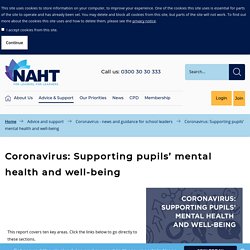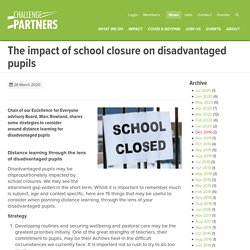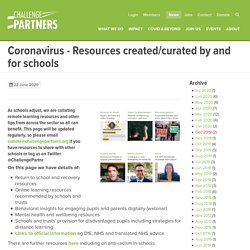

Catch up!! – Bald Headteacher. My wife had pneumonia at the age of ten and missed three months of school.

Her abuelo visited her each day during her recuperation and helped her learn how to draw, taught her equations and read her the latest news. He loved it by all accounts. For her, the illness put a hold on her socialisation with her peers, but she kept on learning. Far from it being a period of emptiness, her family filled the gap left by her absence from school. For many children across the UK, I think the same will be true when school eventually returns to something like normal – the ‘catch-up’ they need will be more social that academic. How Things Have Got Better In Schools Over The Lockdown - Teacher Tapp. 1.

Things Have Mostly Got Better! If you’re a rare teacher who hasn’t heard at least one friend or family member moaning about school closures, then you’re lucky! Many parents were frustrated at the lack of communication and facilities provided by schools, particularly early after the closures. One grievance cropped up most often: teachers weren’t directly speaking to children that often. However, good news! At the end of March, just 27% of primary and 22% of secondary teachers were phone calling children in a given week. Another beef was the lack of video lessons.
As everyone said to the public at the time: this is all very sudden! 2. Another incremental improvement: fewer pupils are now shirking work altogether. One of the big concerns throughout lockdown has been the fact that, back at the end of March, 42% of teachers in schools located in the poorest areas felt their Year 8 pupils were, on average, doing less than 1 hour per day. 3. 4. 5. Right, that’s it for this week. 6. Coronavirus: Supporting pupils’ mental health and well-being.
This report covers ten key areas.

Click the links below to go directly to these sections. This guidance aims to help school leaders and their staff, in all phases of education, support children and young people with their mental health and well-being in light of the impact of the coronavirus pandemic, by outlining some universal approaches for all pupils and for with those with low-level mental health needs. We recognise there will be groups of children and young people for whom the impact of the coronavirus pandemic has created more serious levels of concern.
These pupils need additional support and they will likely need more specialist help from health or social care services. Schools should be particularly alert to those with pre-existing mental health conditions and those with experiences directly related to the coronavirus, such as illness and bereavement. The impact of coronavirus on children and young peoples’ mental health and well-being ^Jump to the top of the page. Online, distance and home learning: Selected reading. This selected reading list is one of three put together relating to the current COVID-19 outbreak.

This list originally included a wider range of themes, but as the number of links increased it has now been split into three for easier navigation. Online, distance and home learning: Selected reading (this list) The first selected reading list, on this page, relates specifically to online and home learning, including research and blogs about home learning, online learning (including using multimedia, online assessment, e-safety and more), about supporting parents and parental engagement, about pupil and teacher wellbeing, and about online teacher CPD. The impact of school closures: Selected reading. The impact of school closure on disadvantaged pupils. Disadvantaged pupils may be disproportionately impacted by school closures.

We may see the attainment gap widen in the short term. Whilst it is important to remember much is subject, age and context specific, here are 15 things that may be useful to consider when planning distance learning, through the lens of your disadvantaged pupils. Developing routines and securing wellbeing and pastoral care may be the greatest priorities initially. One of the great strengths of teachers, their commitment to pupils, may be their Achilles heel in the difficult circumstances we currently face. It is important not to rush to try to do too much.In line with the EEF’s implementation guidance, the most sustainable, effective approaches will be developed over time.Encourage self-regulated learning, build and sustain motivation, don’t overload with tasks from multiple online platforms.
Coronavirus - Resources created/curated by and for schools. As schools adjust, we are collating remote learning resources and other tips from across the sector so all can benefit.

This page will be updated regularly, so please email comms@challengepartners.org if you have resources to share with other schools or tag us on Twitter @ChallengePartnr On this page we have details of: Return to school and recovery resourcesOnline learning resources recommended by schools and trustsBehavioral insights for engaging pupils and parents digitally (webinar)Mental health and wellbeing resources Schools and trusts' provision for disdvantaged pupils including strategies for distance learning Links to official information eg DfE, NHS and translated NHS advice There are further resources here including on anti-racism in schools.
Return to school. BAMEed Network Schools and Covid 19 guidance for BAME staff and their employers 2.